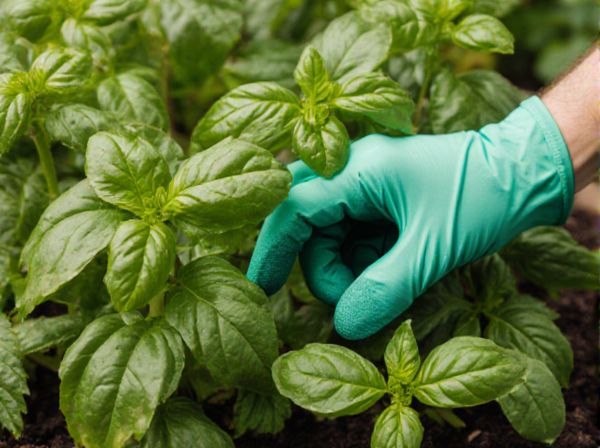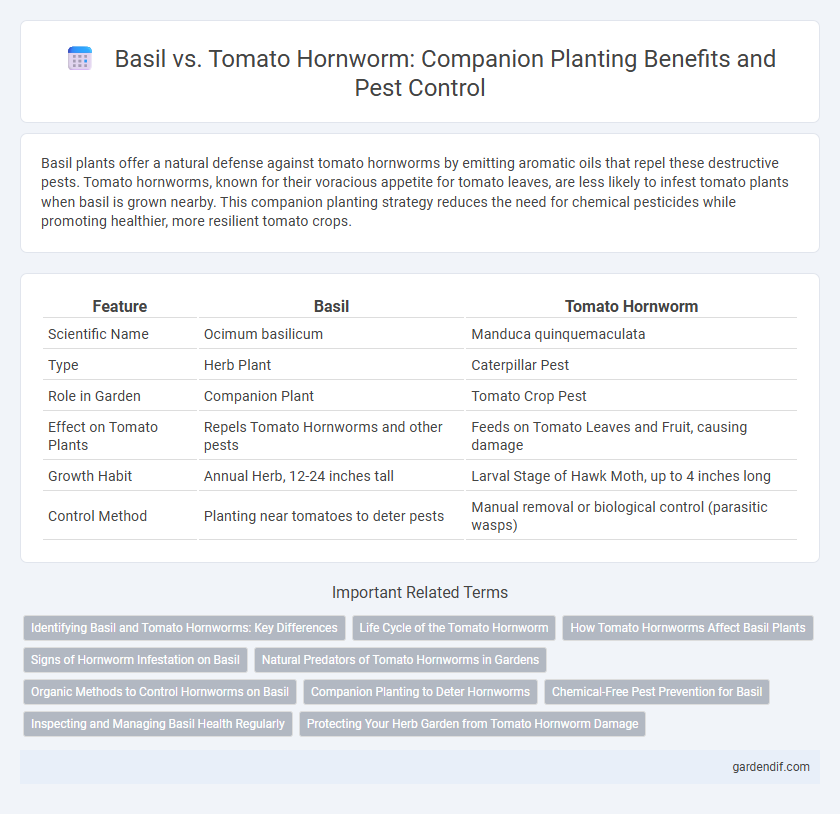
Basil vs tomato hornworm Illustration
Basil plants offer a natural defense against tomato hornworms by emitting aromatic oils that repel these destructive pests. Tomato hornworms, known for their voracious appetite for tomato leaves, are less likely to infest tomato plants when basil is grown nearby. This companion planting strategy reduces the need for chemical pesticides while promoting healthier, more resilient tomato crops.
Table of Comparison
| Feature | Basil | Tomato Hornworm |
|---|---|---|
| Scientific Name | Ocimum basilicum | Manduca quinquemaculata |
| Type | Herb Plant | Caterpillar Pest |
| Role in Garden | Companion Plant | Tomato Crop Pest |
| Effect on Tomato Plants | Repels Tomato Hornworms and other pests | Feeds on Tomato Leaves and Fruit, causing damage |
| Growth Habit | Annual Herb, 12-24 inches tall | Larval Stage of Hawk Moth, up to 4 inches long |
| Control Method | Planting near tomatoes to deter pests | Manual removal or biological control (parasitic wasps) |
Identifying Basil and Tomato Hornworms: Key Differences
Basil and tomato hornworms can be differentiated by their physical traits and feeding patterns on plants. Tomato hornworms are typically larger, green with white diagonal stripes and a curved horn on their rear, causing extensive damage to tomato leaves and stems. Basil hornworms, which are rarer, tend to have a smaller size with less distinctive markings and primarily feed on basil leaves, making accurate identification crucial for targeted pest management.
Life Cycle of the Tomato Hornworm
The tomato hornworm undergoes four larval instars during its life cycle, growing from a small egg to a large caterpillar that can reach up to 4 inches in length. After the larval stage, it pupates in the soil for about two weeks before emerging as a five-spotted hawk moth, ready to lay eggs on tomato plants. Basil planted nearby serves as a natural companion that can help repel tomato hornworms due to its strong aroma, reducing the likelihood of infestation during the caterpillar's vulnerable egg and larval stages.
How Tomato Hornworms Affect Basil Plants
Tomato hornworms cause significant damage to basil plants by feeding on their leaves, leading to defoliation and reduced photosynthesis, which stunts growth. These pests inject enzymes that weaken basil's cellular structure, making the plants more susceptible to diseases. Heavy infestations can result in the complete loss of basil foliage, severely diminishing both yield and flavor quality.
Signs of Hornworm Infestation on Basil
Hornworm infestation on basil is often identified by large, irregular holes in the leaves and the presence of green or brown larvae with a horn-like tail. Wilted, yellowing leaves and dark green droppings, commonly called frass, scattered on the stems or soil also indicate hornworm activity. Early detection of these signs helps in managing and protecting basil plants from significant damage.
Natural Predators of Tomato Hornworms in Gardens
Basil acts as a companion plant that naturally repels tomato hornworms by emitting aromatic oils disliked by these pests. Natural predators of tomato hornworms in gardens include parasitic wasps, which lay eggs on the hornworms, and birds such as chickadees and orioles that feed on the larvae. Integrating basil alongside tomato plants enhances the effectiveness of these biological control agents, reducing hornworm infestations without chemical intervention.
Organic Methods to Control Hornworms on Basil
Basil plants benefit from organic methods to control tomato hornworms, such as handpicking larvae and employing natural predators like parasitic wasps (Trichogramma spp.). Spraying neem oil or Bacillus thuringiensis (Bt) bioinsecticides effectively reduces hornworm populations without harming beneficial insects. Companion planting basil alongside marigolds and nasturtiums further deters hornworm infestations by confusing and repelling adult moths.
Companion Planting to Deter Hornworms
Basil is an effective companion plant that helps deter tomato hornworms from infesting tomato plants due to its strong aromatic oils. Planting basil near tomatoes creates a natural barrier that confuses and repels hornworms, reducing the likelihood of damage. This companion planting strategy promotes healthier tomato growth and minimizes the need for chemical pest control.
Chemical-Free Pest Prevention for Basil
Basil naturally repels tomato hornworms through the release of aromatic compounds like eugenol and linalool, which act as natural insect deterrents without the need for chemical pesticides. Planting basil alongside tomatoes creates a chemical-free pest prevention strategy by confusing or repelling tomato hornworms, reducing damage and promoting healthier plant growth. This companion planting method supports sustainable gardening practices by minimizing harmful chemical runoff and fostering a balanced ecosystem.
Inspecting and Managing Basil Health Regularly
Regularly inspecting basil plants for signs of tomato hornworm damage ensures early detection and effective management of infestations. Monitoring leaves for holes, wilting, or frass buildup allows gardeners to remove larvae promptly, preserving basil health. Implementing natural predators like parasitic wasps can further control hornworm populations and protect basil crops.
Protecting Your Herb Garden from Tomato Hornworm Damage
Basil acts as a natural companion plant that repels tomato hornworms, significantly reducing the risk of these pests damaging your herb garden. The strong aroma of basil confuses hornworms, making it difficult for them to locate tomato plants and thereby protecting your valuable crops. Planting basil alongside your tomatoes creates an effective, eco-friendly barrier against tomato hornworm infestations.
Basil vs tomato hornworm Infographic

 gardendif.com
gardendif.com